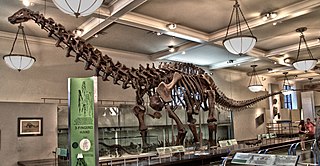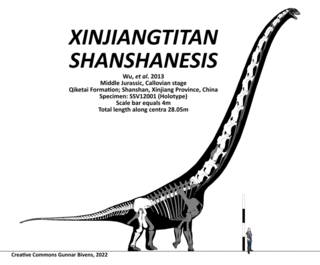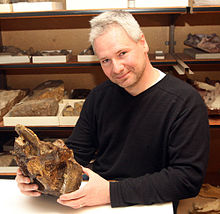
Apatosaurus is a genus of herbivorous sauropod dinosaur that lived in North America during the Late Jurassic period. Othniel Charles Marsh described and named the first-known species, A. ajax, in 1877, and a second species, A. louisae, was discovered and named by William H. Holland in 1916. Apatosaurus lived about 152 to 151 million years ago (mya), during the late Kimmeridgian to early Tithonian age, and are now known from fossils in the Morrison Formation of modern-day Colorado, Oklahoma, New Mexico, Wyoming, and Utah in the United States. Apatosaurus had an average length of 21–23 m (69–75 ft), and an average mass of 16.4–22.4 t. A few specimens indicate a maximum length of 11–30% greater than average and a mass of approximately 33 t.

Supersaurus is a genus of diplodocid sauropod dinosaur that lived in North America during the Late Jurassic period. The type species, S. vivianae, was first discovered by Vivian Jones of Delta, Colorado, in the middle Morrison Formation of Colorado in 1972. The fossil remains came from the Brushy Basin Member of the formation, dating between 153 to 145 million years ago. It is among the longest dinosaurs ever discovered, with the three known specimens reaching 33–40 meters (108–131 ft) in length, with the largest individual possibly exceeding 40 meters (130 ft) in size. Mass estimates for the WDC and BYU specimens tend to be around 35–44 metric tons in body mass. A potential second species, S. lourinhanensis (Dinheirosaurus), is known from Portugal and has been dated to a similar time.

Sauroposeidon is a genus of sauropod dinosaur known from several incomplete specimens including a bone bed and fossilized trackways that have been found in the U.S. states of Oklahoma, Wyoming, and Texas.

Bruhathkayosaurus is a controversial genus of sauropod dinosaur found in the Kallamedu Formation of India. The fragmentary remains were originally described as a theropod, but it was later determined to be a titanosaurian sauropod. Length estimates by researchers exceed those of the titanosaur Argentinosaurus, as longer than 35 metres (115 ft) and weighing over 80 tonnes. A 2023 estimate placed Bruhathkayosaurus as potentially weighing approximately 110–170 tonnes, with paleontologist Michael Benton, giving Bruhathkayosaurus a length of 45 metres (148 ft). If the upper estimates of the 2023 records are accurate, Bruhathkayosaurus may have rivalled the blue whale as one of the largest animals to ever exist. However, all of the estimates are based on the dimensions of the fossils described in Yadagiri and Ayyasami (1987), and in 2017, it was reported that the holotype fossils had disintegrated and no longer exist.

Barosaurus was a giant, long-tailed, long-necked, plant-eating sauropod dinosaur closely related to the more familiar Diplodocus. Remains have been found in the Morrison Formation from the Upper Jurassic Period of Utah and South Dakota. It is present in stratigraphic zones 2–5.
The Isle of Wight is one of the richest dinosaur localities in Europe, with over 20 species of dinosaur having been recognised from the early Cretaceous Period, some of which were first identified on the island, as well as the contemporary non-dinosaurian species of crocodile, turtle and pterosaur.

Haplocanthosaurus is a genus of intermediate sauropod dinosaur. Two species, H. delfsi and H. priscus, are known from incomplete fossil skeletons. It lived during the late Jurassic period, 155 to 152 million years ago. The type species is H. priscus, and the referred species H. delfsi was discovered by a young college student named Edwin Delfs in Colorado, United States. Haplocanthosaurus specimens have been found in the very lowest layer of the Morrison Formation, along with Hesperosaurus mjosi, Brontosaurus yahnahpin, and Allosaurus jimmadseni.

Darren William Naish is a British vertebrate palaeontologist, author and science communicator.

Brontosaurus is a genus of herbivorous sauropod dinosaur that lived in present-day United States during the Late Jurassic period. It was described by American paleontologist Othniel Charles Marsh in 1879, the type species being dubbed B. excelsus, based on a partial skeleton lacking a skull found in Como Bluff, Wyoming. In subsequent years, two more species of Brontosaurus were named: B. parvus in 1902 and B. yahnahpin in 1994. Brontosaurus lived about 156 to 146 million years ago (mya) during the Kimmeridgian and Tithonian ages in the Morrison Formation of what is now Utah and Wyoming. For decades, the animal was thought to have been a taxonomic synonym of its close relative Apatosaurus, but a 2015 study by Emmanuel Tschopp and colleagues found it to be distinct. It has seen widespread representation in popular culture, being the archetypal "long-necked" dinosaur in general media.

Camarasauridae is a family of sauropod dinosaurs. Among sauropods, camarasaurids are small to medium-sized, with relatively short necks. They are visually identifiable by a short skull with large nares, and broad, spatulate teeth filling a thick jaw. Based on cervical vertebrae and cervical rib biomechanics, camarasaurids most likely moved their necks in a vertical, rather than horizontal, sweeping motion, in contrast to most diplodocids.

Xenoposeidon is a genus of rebbachisaurid sauropod dinosaur from the Early Cretaceous of England, living about 140 million years ago. It is known from a single partial vertebra with unusual features, unlike those of other sauropods. This bone was first discovered in the early 1890s but received little attention until it was found by University of Portsmouth student Mike Taylor, who formally described and named it in 2007 with Darren Naish.

Apatosaurinae is a subfamily of diplodocid sauropods, an extinct group of large, quadrupedal dinosaurs, the other subfamily in Diplodocidae being Diplodocinae. Apatosaurines are distinguished by their more robust, stocky builds and shorter necks proportionally to the rest of their bodies. Several fairly complete specimens are known, giving a comprehensive view of apatosaurine anatomy.

Qiaowanlong is a genus of sauropod dinosaur. Fossils belonging to the genus were found in 2007 from the Yujinzi Basin of Gansu, China, and were described in 2009 in the Proceedings of the Royal Society B. The remains come from a geological formation called the Xiagou Formation in the Xinminpu Group, dating to the Early Cretaceous. The only known specimen consists of articulated cervical (neck) vertebrae and a right pelvic girdle, as well as several unidentified bone fragments. Qiaowanlong was initially reported as the first brachiosaurid to have been found from China. However, later analysis found that it was more closely related to titanosauriformes like Euhelopus and Erketu. It is estimated to have had a length of around 12 metres (39 ft) and would have weighed around 6 tonnes. The type species is Q. kangxii.
Clash of the Dinosaurs is a four-part television mini-series produced by Dangerous LTD for Discovery Channel. The show premiered on December 6, 2009, with the first two episodes scheduled back-to-back.

Epipophyses are bony projections of the cervical vertebrae found in archosauromorphs, particularly dinosaurs. These paired processes sit above the postzygapophyses on the rear of the vertebral neural arch. Their morphology is variable and ranges from small, simple, hill-like elevations to large, complex, winglike projections. Epipophyses provided large attachment areas for several neck muscles; large epipophyses are therefore indicative of a strong neck musculature.

All Yesterdays: Unique and Speculative Views of Dinosaurs and Other Prehistoric Animals is a 2012 art book on the palaeoartistic reconstruction of dinosaurs and other extinct animals by John Conway, C. M. Kosemen and Darren Naish. A central tenet of the book concerns the fact that many dinosaur reconstructions are outdated, overly conservative, and inconsistent with the variation observed in modern animals. This focus is communicated through an exploration of views of dinosaurs and related animals that are unusual and sometimes even confusing to viewers, but which are well within the bounds of behaviour, anatomy and soft tissue that we see in living animals.

Xinjiangtitan is an extinct genus of mamenchisaurid sauropod that lived during the Middle Jurassic of what is now Xinjiang, northwestern China. Its type and only species is Xinjiangtitan shanshanesis, known from a single incomplete skeleton recovered from the Qiketai Formation. The holotype preserves one of the most complete vertebral columns of any sauropod found in Asia, and has the longest complete neck known for any animal.

Mathew John Wedel is an American paleontologist. He is associate professor at the Western University of Health Sciences Department of Anatomy in California. Wedel studies sauropods and the evolution of pneumatic bones in dinosaurs. At Western University, Wedel teaches gross anatomy. He has authored papers naming Aquilops (2014), Brontomerus (2011), and Sauroposeidon (2000). He has published research exploring how some dinosaurs achieved large sizes. In 2016, he co-authored the book The Sauropod Dinosaurs.

Robert (Bob) Nicholls is a British paleoartist.

















